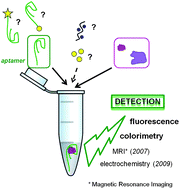Homogeneous assays using aptamers
Abstract

- This article is part of the themed collection: Highlighting analytical science in France, Italy and Spain
* Corresponding authors
a
CNRS, UMR 5246, ICBMS, Institut de Chimie et Biochimie Moléculaires et Supramoléculaires, Génie Enzymatique, Membranes Biomimétiques et Assemblages Supramoléculaires (GEMBAS), Université Lyon 1, Bât CPE, 43 boulevard du 11 novembre 1918, Villeurbanne, France
E-mail:
leca@univ-lyon1.fr
Fax: +33 472 44 79 70
Tel: +33 472 44 82 14
b Université de Lyon, Villeurbanne, France
c INSA-Lyon, Villeurbanne, France
d CPE Lyon, Villeurbanne, France

 Please wait while we load your content...
Something went wrong. Try again?
Please wait while we load your content...
Something went wrong. Try again?
A. Sassolas, L. J. Blum and B. D. Leca-Bouvier, Analyst, 2011, 136, 257 DOI: 10.1039/C0AN00281J
To request permission to reproduce material from this article, please go to the Copyright Clearance Center request page.
If you are an author contributing to an RSC publication, you do not need to request permission provided correct acknowledgement is given.
If you are the author of this article, you do not need to request permission to reproduce figures and diagrams provided correct acknowledgement is given. If you want to reproduce the whole article in a third-party publication (excluding your thesis/dissertation for which permission is not required) please go to the Copyright Clearance Center request page.
Read more about how to correctly acknowledge RSC content.
 Fetching data from CrossRef.
Fetching data from CrossRef.
This may take some time to load.
Loading related content
